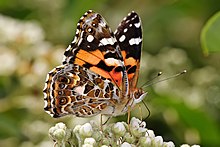Australian painted lady
| Australian painted lady | |
|---|---|
 |
|
| Victoria, Australia | |
| Scientific classification | |
| Kingdom: | Animalia |
| Phylum: | Arthropoda |
| Class: | Insecta |
| Order: | Lepidoptera |
| Family: | Nymphalidae |
| Genus: | Vanessa |
| Subgenus: | Cynthia |
| Species: | V. (C.) kershawi |
| Binomial name | |
|
Vanessa (Cynthia) kershawi (McCoy, 1868) |
|
| Synonyms | |
|
|
The Australian painted lady (Vanessa kershawi) butterfly is mostly confined to Australia, although westerly winds have dispersed it to islands east of Australia, including New Zealand. Debate surrounds the taxonomy of this species. Some believe that the Australian painted lady should be a subspecies to the painted lady (Vanessa cardui) due to the similarity in lifestyle and behaviour. Furthermore, the painted lady is found around the globe, but Australia is the only location in which it varies enough to be considered a separate species. However, due to the distinct genitalia of the males, and variation in colouration, many others consider the Australian painted lady to be a separate species. During spring, adult butterflies migrate south in large numbers from northern states of Queensland and New South Wales. To find mates, male Australian painted ladies exhibit territorial behaviour, which involves a male perching on vegetation in a sunny spot on a hilltop, waiting for females to fly by. Despite urbanization and invasive plants altering its habitat, populations of Australian painted ladies have not been significantly impacted by these changes.
The Australian painted lady is remarkably similar to the painted lady (Vanessa cardui). It is differentiated by its smaller size, rarely exceeding 2 inches (5 cm) across its wings, and the blue colouration at the centre of the four eyespots on its hindwings. Its body is dark brown, almost black, all over, except the tips of the antenna which are white. The base of the wings are brown, which turns into a brick red colouration, broken by bands of black. The tips of the forewing are black with four white dots running from the apex of the wing, and a white bar extending from the leading edge of the forewing. The hindwings have four round eyespots at their base, with a blue centre for at least three. The underwings are almost identical to the upperwings, except the base of the underwings is brick red rather than brown. The Australian painted lady's colouration allows it to blend in effectively with the ground. Males and females look almost identical. The ovum is translucent green in colour and barrel shaped with 13 to 15 vertical ribs. Right before hatching, the black head and grey-tinted body appear through the shell. The larva is grey with pale yellow stripes along each side of its body, yellow dots, and has rows of branched spines covering its body. Its head is typically brown or black, and the caterpillar grows to about 3 cm. The pupa is brown with darker markings, and four pairs of metallic silver or gold dots.
...
Wikipedia
